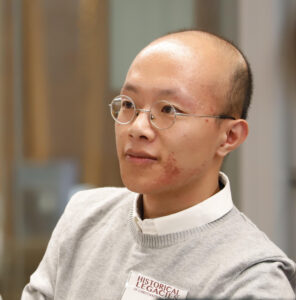As guest editors, we appreciate ChinaSource’s commitment to inclusivity, balance, and flexibility, which allows us to honor our preference for using traditional Chinese characters throughout this issue for the sake of overall consistency. While our contributors may use different scripts in their original writing, presenting this issue in a unified format ensures coherence and readability while continuing to reflect the diversity of voices and perspectives shared in these pages.
The Sinicization (Zhongguohua, 中國化) of Christianity in China can historically be seen as both a political strategy and a religious negotiation. In 1993, Jiang Zemin mandated that religion adapt to socialism and ordered religious institutions to reform in harmony with socialist doctrines.1 This United Front policy set the stage for a more assertive push toward ideological conformity, which would take full shape two decades later under Xi Jinping. In 2014, the state-sanctioned Three-Self Patriotic Movement (TSPM) and the China Christian Council (CCC) formally introduced Sinicization as a guiding principle for Protestant Christianity. In 2015, at a national United Front Work Department (UFWD) conference, Xi Jinping declared Sinicization the official direction for all religions in China. In 2017, at the 19th National Congress of the Communist Party of China, he reaffirmed this policy as a key element of religious governance. The party-state defines religious expression in ideological terms and integrates it into its broader framework of national unity and security.
Contemporary debates on the Sinicization of Chinese religions have taken different strategic directions. The United States government calls it “China’s coercive religious policy”2; some scholars follow the newer official translation of “developing religions in the Chinese context,”3 while others associate the historical project of Sinicization predominantly with that of cross-cultural negotiation (particularly in the case of Protestantism and Catholicism4). Critics decry the “political domestication”5 or, more pointedly, the Xi-ist regulation6 of a nationalist policy. Translations of “基督教中國化” in particular—that is, the Zhongguohua of Protestantism—have in recent years swung back and forth between various neologisms, the less precise interpretation of “contextualization,” and the more common rendering, “Sinicization.”7 The phrases explaining this notion also have their standard English translations. China’s religions are to be developed in a Chinese style (中國式), with Chinese characteristics (中國特色), and in line with Chinese socialism.
While these English translations are not decisive, they relate to China’s global image-building, as discussed in Chin Ken Pa’s article in this issue. From a policy viewpoint, developing Chinese religions is not a socio-cultural or religious concern but one of international relations and national security. In his preface to a recent book series entitled, “Studies on Religion and China’s National Security and International Strategy,”8 Xu Yihua stresses the need for a two-fold strategy that manages the security risks posed by the infiltration of foreign religions while “enhancing China’s international image” through international religious diplomacy.9
The present issue of the ChinaSource Journal explores this and related backgrounds to notions of religious Sinicization not routinely explored in English-language sources. Contributions to this issue introduce lesser-known discussions in Chinese academia, bringing clarity and substance to some of the conceptual confusion over Sinicization, which remains a notion associated with diverse movements and agendas. This particular issue focuses on state-sanctioned institutions, but it does not address the impact of Sinicization on house churches, which remains an open question for further study.
In his lead article, He Guanghu reframes this debate from the perspective of religious studies; Ying Fuk-tsang reiterates that the cross-cultural encounter between China and a foreign religion, for religious proselytizers, means not only the Sinicization of Christianity but, first and foremost, the Christianization of China. Chin Ken Pa’s analysis of the dual goals of official Sinicization/Zhongguohua also highlights the irreligious rationale of this policy, presented to religious communities as patriotic faith and to the outside world as Chinese religion. Sociologist Richard Madsen, who has published extensively on the subject, contributes a short piece here on the United Front and Zhongguohua, defining the concept negatively and in contrast also to Catholic understandings of cultural accommodation. Finally, Eva-Maria Hanke-Estevez’s overview sheds light on Xi’s recent policy and its background. Taken together, these texts draw a clearer picture of how Chinese religious policy shapes the landscape of Chinese Christianity and religion in China more generally by charting a unified direction and constructing an identity not, however, claimed by all of China’s faithful.
Endnotes
- Ying Fuk-tsang 邢福增, “Mutual Adaptation to Socialism: TSPM and Church-State Relations,” in Concilium: International Review of Theology 2008, no. 2 (June): 71-87; Ryan Dunch, “Christianity and ‘Adaptation to Socialism’,” in Chinese Religiosities: Afflictions of Modernity and State Formation, ed. Mayfair Mei-hui Yang (Berkeley: University of California Press, 2008), 155-178.
- Dylan Schexnaydre, “Sinicization of Religion: China’s Coercive Religious Policy,” United States Commission on International Religious Freedom, September 2024, accessed January 25, 2025, https://www.uscirf.gov/sites/default/files/2024-09/2024%20China%20Factsheet%20Sinicization.pdf.
- This focus echoes the official line of recent years. Cf. “Xi Stresses Developing Religions in Chinese Context,” China Daily, December 4, 2021, accessed January 31, 2025, https://www.chinadaily.com.cn/a/202112/04/WS61ab4c56a310cdd39bc7961b.html, and other sources reporting on Xi’s address to a national conference on religious affairs held December 3-4, 2021, in Beijing. The expression “堅持我國宗教中國化方向” [promote the direction of the Sinicization of Chinese religions] is often used in official rhetoric; “宗教中國化” [Sinicization of Chinese religions] is also embedded in the current five-year plan for the continued promotion of the Sinicization of Chinese religions: “深入推廣我國基督教中國化五年工作規劃綱要 (2023-2027年) [Five-Year Planning Outline for Advancing the Sinification of Christianity (2023-2027).”
- Cf. Tao Feiya 陶飛亞, and Philip L. Wickeri, eds., “Preface,”《中國基督宗教史 (635-1949): 一種跨文化視野》 [History of Christianity in China (635-1949): An Inter-Cultural Perspective] (Beijing: Social Sciences Academic Press, 2024).
- Yang Fenggang楊鳳崗, “Xi Jinping Is Not Trying to Make Christianity More Chinese,” Christianity Today, January 16, 2024, accessed 28 January 2025, https://www.christianitytoday.com/2024/01/china-christianity-xi-religion-policy-sinicization/.
- See Ray Wang, “Sinicisation or ‘Xinicisation’ [sic.]: Regulating Religion and Religious Minorities under Xi Jinping,” in Political and Social Control in China: The Consolidation of Single-Party Rule, edited by Ben Hillman and Kou Chien-Wen (Canberra: ANU Press, 2024), 247-280, http://www.jstor.org/stable/jj.16487862.16.
- Cf. recent issues of translated articles in the Chinese Theological Review (CTR), issues 26 (2014) to 31 (2022), for example, “Remarks on the Seminar on Chinization of Christianity in China” (CTR 26); “Build up the Chinese Protestant Church Through Sinicization” (CTR 28); “The Sinicization of Christianity: A Chinese Christian’s Thoughts (CTR 27); “Build Up the Chinese Protestant Church Through Sinicization” (CTR 28); “Five-Year Outline Plan [sic.] to Promote the Contextualization of Protestant Christianity in China (2018-2022)” (CTR 29); “Continue the Further Contextualization of Christianity in China and Enhance the Church’s Adaptation to Socialist Society” (CTR 31).
While printed English works such as President Xi’s collected speeches published by the Foreign Language Press in English and Chinese consistently render 中國化 “Sinicization” in English, some online translations of government-issued texts also deviate from this. For example, Xu Xiaohong’s 2019 speech on the topic, “堅持我國基督教中國化方向 積極與社會主義社會相適應” was rendered, “Adhering to the indigenization and contextualization of Christianity in China and making it suitable for a socialist society” by China Daily, the English-language CCP organ. Another point worth noting is that the English translation of Xi Jinping’s Report to the 20th National Congress of the Communist Party of China does not use the term Sinicization with reference to religion, but instead reiterates continued commitment to the “principle that religions in China must be Chinese in orientation and provide active guidance to religions so that they can adapt to socialist society.” “Sinicization,” therefore, while appearing in print as the official English translation of 中國化 for many years, is now one of many renderings. For “Sinicization” as a standard translation, see Xi Jinping 習近平, 《習近平談治國理政,第一卷-第四卷》[The Governance of China, I-IV] (Beijing: Foreign Languages Press, 2014-2022). These volumes are published by the Foreign Languages Press in Chinese and other languages.
- Xu Yihua 徐以驊ed., 《宗教與中國國家安全與對外戰略論叢》 [Religion and China’s National Security and Foreign Policy Series] (Shanghai: Shanghai People’s Publishing House, 2015).
- Xu Yihua 徐以驊, “Series Preface,” in Zhang Hua 張化, 《社會中的宗教: 觀察與研究》 [Religion in Society: Observation and Research] (Shanghai: Shanghai People’s Publishing House, 2015), 1-3.
Image credit: Joann Pittman

Jordan Wang
Jordan Wang is a historian of World Christianity. He received his PhD in Religious Studies from The Chinese University of Hong Kong. He co-founded AI-demia, an academic consultancy startup. He is currently a sessional instructor at the University of Alberta and Ambrose Seminary. His research interests focus on public theology, …View Full Bio

Naomi Thurston
Naomi Thurston is a scholar of contemporary Chinese Christianity based at The Chinese University of Hong Kong (CUHK). Her research focuses on the contributions of Chinese intellectuals to issues in contextual and academic theology and Christian studies. She has translated the writings of contemporary Chinese scholars and currently serves as the director of …View Full Bio